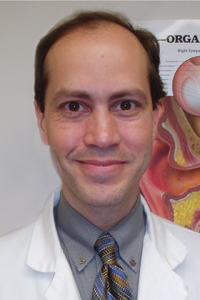Doctor finds unsolved ear pain is often migraine


Most people don’t go to their ENT for a migraine. Then again, most people may be unaware that headache pain is only one of many symptoms of migraine, which can present as dizziness, chronic sinus pain, tinnitus, sensitivity to sound and even earache.
“A lot of people who have migraine are undertreated,” said Michael Teixido, M.D., an otolaryngologist and director of the Balance and Mobility Center of Christiana Care. “Of all the people with migraine, only about half of them know they have it. And only about 30 percent of people with diagnosed migraine are satisfied with treatment. There is a lot of room for improvement in migraine therapy.”
Dr. Teixido has spent 15 years learning about and treating atypical migraine symptoms. Earlier this year, he published an article describing a seven-year study showing that unexplained ear pain can be a symptom of migraine and alleviated by migraine therapy. The paper, titled “Otalgia Associated with Migraine,” appeared in the February issue of the journal Otology & Neurotology.
“Over a seven-year period, I treated many patients with ear pain, and in 50 I could not discover the cause of their pain,” Dr. Teixido said. “I offered all of them migraine treatment, and most of them responded.”
On average, these patients had been suffering with ear pain for at least five years. Many of them had never been diagnosed with migraine. Once Dr. Teixido initiated migraine therapies, patients began to feel relief within two to three weeks.
Using rigorous scientific standards to account for placebo effect and the possibility his patients were improving spontaneously, Dr. Teixido came to the conclusion that he had identified a new clinical entity he calls migraine-associated otalgia. The findings could have life-changing implications for those patients who live with atypical migraine symptoms for years without receiving a diagnosis or finding effective treatment.
Physicians should take note of the study’s results, Dr. Teixido says. Primary-care physicians and otolaryngologists, who normally consider migraine to be the provenance of neurologists, likely see patients every day with unexplained ear pain, dizziness or other symptoms that could be related to migraine, even if the patient isn’t experiencing the typical headache pain.
“In my specialty, every doctor knows these patients,” Dr. Teixido says. “We’ve done CT scans and MRIs and looked at their throats and ears and, when we can’t figure out the cause of their symptoms, we should treat for migraine.”